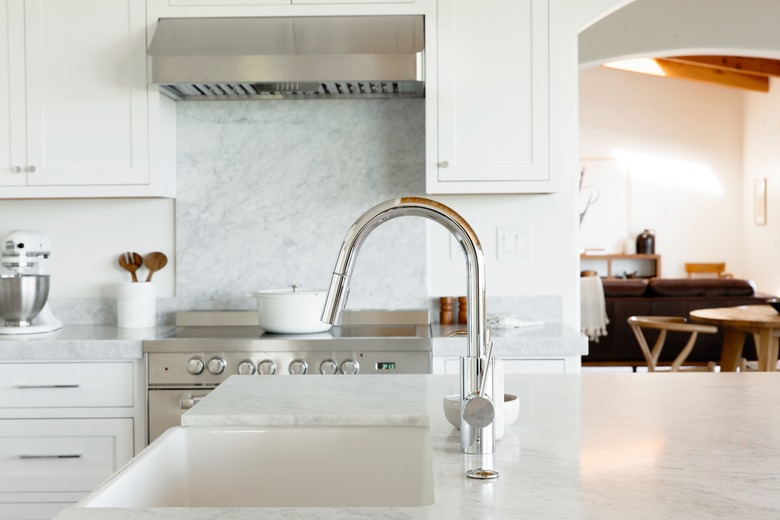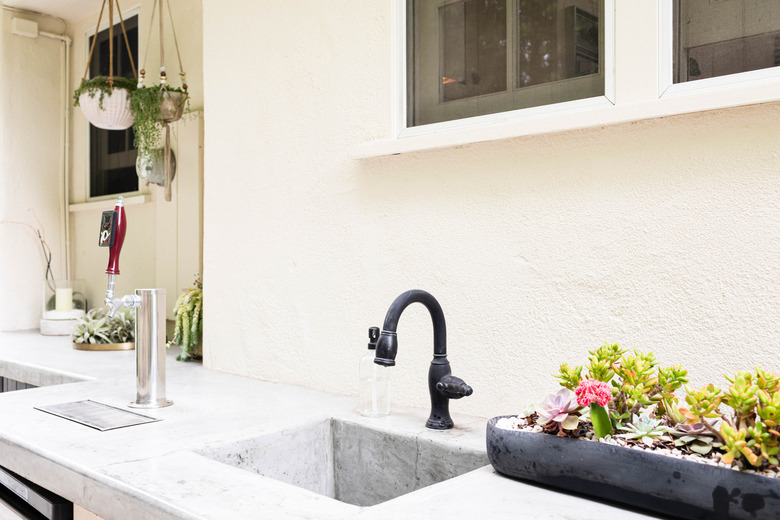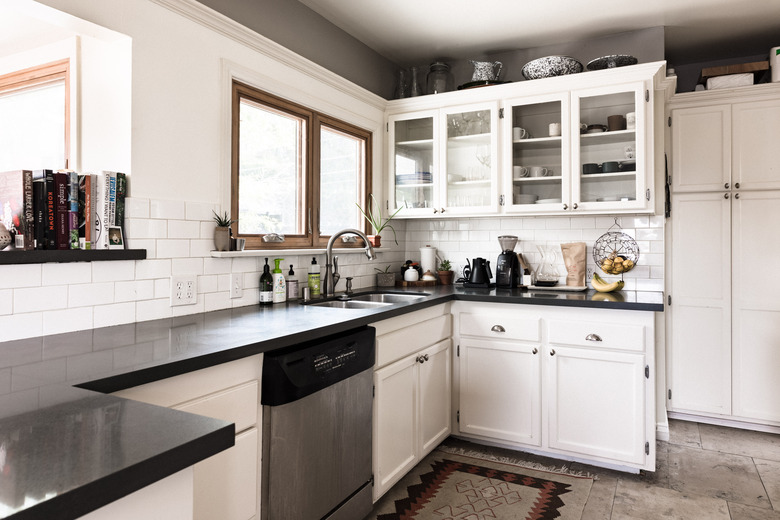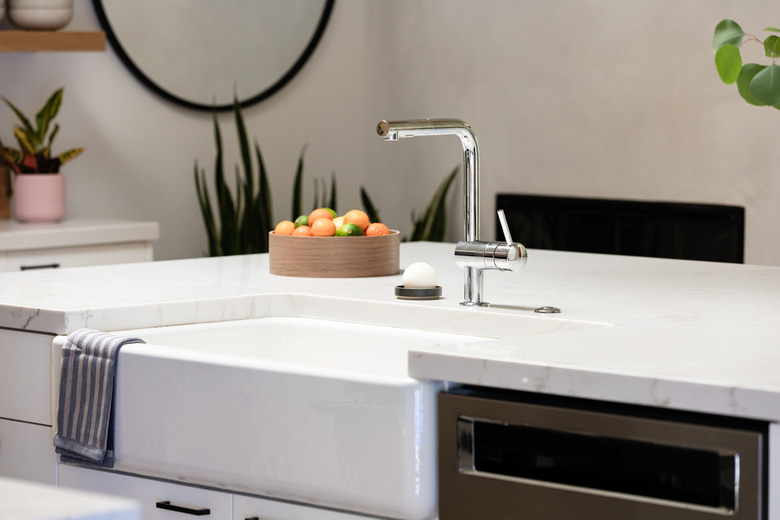Single-Handle Kitchen Faucets: A Homeowner's Guide
We may receive a commission on purchases made from links.
What's better than two handles on a kitchen or bathroom faucet? If you're Al Moen, the inventor of the mixing faucet, your answer is: a single handle. Moen conceived and built the first cartridge-style, single-handle faucet in 1936 after having been scalded one too many times by his double-handle faucet, and the Moen company has specialized in the cartridge faucet ever since. Other companies, such as Delta, soon came up with their own single-handle faucet designs, and as a result, modern consumers have a vast array of single-handle faucet models from which to choose.
A single-handle faucet has one of three internal mechanisms — a cartridge, ball-valve or ceramic disk — that allows you to adjust water temperature and flow using only one hand. Besides being easier to use, a single-handle faucet has a more contemporary appearance than a double-handle one, and it can be more functional by including such features as a temperature limiter for anti-scald protection and a pull-down or pull-out spray head. The one thing it won't add to your kitchen or bathroom is a retro or vintage element because mixing faucets don't have a long history.
Why Choose a Single-Handle Faucet?
Why Choose a Single-Handle Faucet?
Deciding on the number of handles for a new faucet isn't always easy given that each handle configuration has its own advantages and disadvantages. Some reasons to opt for a faucet with a single handle include:
- It's more compact: A single-handle faucet takes less space than a double-handle one and is a better choice if you have a small sink or limited space on the counter. It's a great choice for a bar faucet.
- It's easier to use: If your household has disabled individuals or you're designing an ADA-compliant kitchen or bathroom, you should opt for a single-handle faucet. It allows you to control both water flow and temperature at the same time without using both hands.
- You want extra functionality: Faucets with pull-out or pull-down spray heads, which are becoming increasingly popular, typically have a single handle. Some manufacturers, such as Delta and Pfister, offer a two-handle pull-down kitchen faucet, but compared to the single-handle version, the double-handle pull-down faucet is relatively rare.
- Your sink has one or two holes: Most single-handle faucets require a single hole in the sink deck or countertop, and if that's how many holes there are in your sink, you need a single-handle faucet. If your sink or countertop has two holes, you need a single-handle faucet with a detached handle.
The Valves That Make Mixing Faucets Possible
The Valves That Make Mixing Faucets Possible
The old-fashioned screw-down compression valves and the cartridge valves found in budget two-handle faucets control flow rate but not temperature. Mixing valves can do both because they receive water from the hot and cold sides at the same time and can regulate the amount of each that comes through the spout based on the faucet handle's position. Valves that can do this have a series of strategically spaced holes that gradually open or close as you turn the handle.
The cartridge, which is the type of valve that Moen invented, is usually cylindrical, and while some of the more heavy-duty ones for shower and tub valves are metal, most of the ones you find in sink faucets are plastic. The cartridge fits into a valve housing in the faucet body, and O-rings and gaskets press against it to stop water when the faucet is off. A ceramic disk is a type of cartridge that employs closely fitting ceramic plates, which wear better and last longer than plastic or metal components and are found in top-of-the-line models, such as the Kohler Rubicon.
The ball valve, which was introduced by Delta, is basically a spherical version of the Moen cartridge. The valve seat is at the top of the faucet body, and the handle or valve cover usually has a dome shape to better fit around the ball, which is an arrangement that allows for less diversity of design. The handle has to swivel around the ball to control temperature and flow, so it must always be mounted above the ball.
Choosing a Single-Handle Kitchen Faucet
Choosing a Single-Handle Kitchen Faucet
Style is one of the top considerations for most people when choosing a faucet, and there is no shortage of fashionable options. Functionality is just as important and may trump style if you're looking for a kitchen faucet. Some of the characteristics to consider include:
- Finish: Chrome is the most common faucet finish, and it works well with most sink materials, especially stainless steel and most countertops. You can also choose polished or brushed nickel or brass to complement a porcelain, enameled cast iron or composite sink and a tile or stone countertop. Single-handle kitchen faucets also come with a white porcelain or matte black finish for an extra touch of design panache.
- Style: The single-handle format allows for minimalist Euro designs that fit with stone or solid-surface countertops, undermount sinks and solid wall colors. Slightly more ornate styles are available but none as contoured or complex as are available in the two-handle format.
- Spout: Single-handle bathroom faucets generally have short spouts, which is all you need for washing your hands in a compact sink, but variations, such as high-arc and semiopen spouts, are available. Kitchen faucets often feature swivel spouts, and high arcs are more common than they are in the bathroom because they provide extra space in the sink for washing dishes.
The Touchless Advantage
The Touchless Advantage
Single-handle valves lend themselves well to touchless technology, which employs a motion sensor that allows you to control water flow with the wave of a hand. Touchless faucets also have handles, which you may need for temperature control depending on the model. A highly rated model is the Moen Arbor, which comes with a pull-down spray head and offers the ability to enable or disable the sensor at will.
There's no doubt that touchless faucets are convenient, especially in homes with disabled individuals. When shopping for an ADA-compliant touchless faucet, keep in mind that it must allow the water to run for at least 10 seconds before shutting off automatically.
Pull-Down and Pull-Out Spray Heads
Pull-Down and Pull-Out Spray Heads
The single-handle, pull-down kitchen faucet can be mounted on any sink with a single predrilled hole, and it offers more versatility and functionality than a side sprayer. The hose that connects the spray head fits through the spout and faucet body and gets connected to the water supply under the cabinet by flexible hoses, so all you see is the faucet itself. You can use the handle to operate the faucet, but the sprayer has a separate control.
Pull-out faucets, like their pull-down counterparts, offer the functionality of a sprayer built into the spout, but rather than a high-arc spout that points downward, a pull-out kitchen faucet spout has a low arc that points outward. This allows the sprayer to reach the stove or countertop, where you can use it for cleaning or filling pots. It also makes it easier to keep a double kitchen sink clean.
Wall-Mount Faucet Options
Wall-Mount Faucet Options
Most wall-mount faucets have two handles, but some manufacturers offer single-handle models. These usually have a detached handle that contains the valve, much like the handle in a shower stall. You can even find single-handle pot-filler faucets, such as the American Standard Studio S Pot Filler, which retails for $575.
Installing a Single-Handle Faucet
Installing a Single-Handle Faucet
The typical single-handle sink faucet requires only one predrilled hole in the sink or countertop, and all the components fit through it, including hot and cold supply tubes and spray hoses. Trying to fit them all together at the same time is reminiscent of a comedy routine in which two people try to get through a door at the same time, though, so the manufacturer usually makes one of the supply tubes longer than the other. If the faucet has a detached handle, the sink or countertop needs two holes, and if there's a detached side sprayer or soap dispenser, a third hole that is offset from the other two is required.
When you've removed the old faucet (if there is one) and cleaned up the sink or countertop, a typical installation procedure for a single-hole faucet looks like:
- Feed the supply tubes and hoses through the hole and rest the faucet on the sink deck or countertop.
- Slide on the washer, screw on the mounting nut from underneath the countertop and tighten the nut by hand.
- Adjust the faucet to center it in position and then tighten the nut with locking pliers or a basin wrench.
- Connect the supply tubes to the shutoff valves with flexible hoses and tighten the connections with pliers. Be sure to check which of the tubes is for hot water and which is for cold. The hot tube usually has a red marking.
- Connect the hoses for the pull-down or pull-out spout or for the side sprayer. These often have quick-connect fittings that you just push together while folding down a tab, but on budget models, you may have to tighten compression nuts with pliers or a wrench.
- Turn on the water, check for leaks and test the faucet.
The procedure is essentially the same for two-hole models except that you have to tighten two mounting nuts instead of just one.
Basic Single-Handle Faucet Repair
Basic Single-Handle Faucet Repair
When a single-handle kitchen faucet or bathroom faucet leaks, it's usually because rubber gaskets or O-rings are worn out, and if the faucet has a ball valve, springs may also be worn. To replace these parts, start by locating a model-specific repair kit either by going to the hardware store or searching the website of the manufacturer or a third-party online plumbing-supply distributor.
After turning off the shutoff valves, you'll have to disassemble the faucet, which involves unscrewing and removing the handle and unscrewing the valve retaining nut. Pull out the valve and inspect it for damage. Then, pull out all the rubber parts and springs using needle-nose pliers if necessary and replace them. If that doesn't fix the problem, you'll have to replace the cartridge or ball valve even if it didn't appear damaged. Some repairs, such as adjusting the temperature limiter, apply only to certain models, and it's best to consult the manufacturer's website for specific instructions.
When the flow rate from the faucet isn't as robust as it should be, it's usually because scale is blocking the aerator or the valve. The aerator is easy to check, although if it's recessed in the spout, you may need an aerator key to unscrew it, and if the spout has a spray head, you'll have to unscrew the head to retrieve it. Soak the aerator in vinegar to dissolve scale. If that doesn't help, remove the valve and soak it because some of the holes through which water flows are small, and they can easily get blocked by scale.



